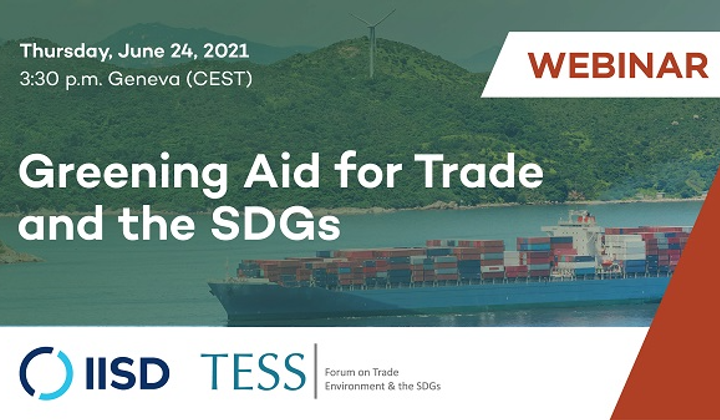Aid for trade is a crucial part of the integrated policy approach needed for trade and trade policies to advance sustainable development and support environmental objectives in least developed countries. At the Eighth Global Review of Aid for Trade on 27–29 July 2022, governments and stakeholders shared views on how best to harness aid for trade to support a just transition to sustainable trade that addresses the needs of developing and least developed countries.
Extreme weather events and changing climate conditions are causing hundreds of millions in economic damage and severe suffering in least developed countries (LDCs). Eritrea, Madagascar, Mauritania, Chad, the Democratic Republic of Congo, Sudan, Mali, Ethiopia, and Congo face climate adaptation costs higher than their national spending on healthcare, with these adaptation costs ranging from around 5–22% of gross domestic product.
The ocean states of Kiribati, the Solomon Islands, and Tuvalu and countries like Bangladesh, Senegal, Tanzania, and Uganda are flooded with plastic pollution with tremendous economic and health costs. From Laos to Madagascar and Guinea, rural populations, which account for two thirds of people living in LDCs, are experiencing the loss of biodiversity and ecosystems on which they directly depend for their subsistence.
Faced with the huge social and economic toll of these planetary environmental crises, despite bearing the least historical responsibility for them, the world’s poorest nations have repeatedly highlighted the need for international support measures, including through Aid for Trade to address their trade-related impacts.
Fostering Aid for Trade for Sustainable Development
As governments and stakeholders work to promote the economic transformations vital to achieving resilient, low carbon, and sustainable development, aid for trade is an important component of the financing and partnerships required to support a just transition for LDCs that supports new economic opportunities and decent work.
To better mobilize and channel the resources they need to tackle challenges and seize opportunities at the intersection of trade, environment, and sustainable development, a top priority is to ensure LDCs are in the driver’s seat with regard to prioritization and coordination of aid for trade.
The Eighth Global Review of Aid for Trade, with its theme of “empowering connected, sustainable trade,” provided partners an opportunity to focus on how to incorporate a stronger focus on environmental issues and a just transition to sustainable trade, guided by the sustainable development priorities of LDCs.
The Role of Aid for Trade in Supporting a Just Transition to Sustainable Tarde
There is broad consensus that the economic burden of the global response to environmental challenges should not fall on the world’s poorest and most vulnerable economies and that developed countries have a responsibility to provide financial resources, capacity building, and technical assistance to bolster capacities in developing countries. In the face of climate change, the importance of collective action and bolstered partnerships to address such crises of the global commons is clear.
However, while commitments to provide capacity building and technical assistance to developing and least developed countries are included in the Sustainable Development Goals and a range of environmental and trade agreements, there are well-recognized shortfalls in the scale of financial and technical support relative to the challenges facing LDCs at the interface of trade, environment and sustainable development.
However, while commitments to provide capacity building and technical assistance to developing and least developed countries are included in the Sustainable Development Goals and a range of environmental and trade agreements, there are well-recognized shortfalls in the scale of financial and technical support relative to the challenges facing LDCs at the interface of trade, environment and sustainable development.
Discussions at this year’s Global Review highlighted a number of ways that aid for trade could be harnessed for a just transition to sustainable trade in LDCs, including through support to: economic diversification so as to participate competitively in green markets and supply chains; boost resilience, climate readiness and adaptation in key export sectors; and build climate-smart and resilient trade-related infrastructure.
To effectively support LDCs, it is also clear that efforts to ‘green’ Aid for Trade need to take into account wider national goals like diversification, resilience, employment creation, and poverty reduction.
Complementary Pathways for Greening Aid for Trade
Greening aid for trade to better respond to environmental priorities in the context of the broader trade and sustainable development objectives will require simultaneous action on six complementary pathways:
- mainstreaming environmental goals in aid for trade planning and projects;
- ensuring aid for trade monitoring systems accurately capture and report information about the environmental purpose and impacts of aid for trade projects;
- securing new and additional resources for environment-related aid for trade, increase the accessibility of Aid for Trade and other sources of finance that can support sustainable trade, and use aid for trade to mobilize further resources;
- fostering coherence between aid for trade and wider efforts to finance the shift to a green global economy, including climate finance, development assistance, green investment, and debt relief;
- integrating trade considerations into existing climate and environmental funding initiatives and in development assistance for sectors with a high environmental impact and trade dimension; and
- strengthening South-South cooperation on sustainable trade, including by learning from developing country experiences and existing practices that support environmental sustainability in trade.
As noted, boosting the contribution of aid for trade to sustainability goals will require complementary efforts to ensure that trade rules and policies address LDC priorities and constraints as well as an international policy framework that supports LDCs to be partners in and benefit from opportunities in environmentally sustainable trade.
Critically, harnessing aid for trade for a just transition to sustainable trade must put developing countries in the lead—listening and responding to their priorities in the area of sustainable trade. For LDCs, effective priority-setting can be bolstered by integrated policymaking involving a diversity of relevant government ministries and regular consultations with stakeholders—including local businesses, civil society, and researchers. Further, ensuring that aid for trade is aligned with nationally defined sustainable development and sustainable trade priorities will entail national-level leadership and coordination of donors and donor projects by LDCs.
Next Steps for a Just Transition to Sustainable Trade in Least Developed Countries
Building on discussions at the Eighth Global Review of Aid for Trade, governments could agree to pursue the development of a clear set of environmental goals, priorities, and targets for the 2022–2024 aid for trade work programme, underpinned by LDC sustainable development objectives. To support this work on an ongoing basis, they could agree to convene joint sessions of the WTO Committee on Trade and Development and the Committee on Trade and Environment focused on priorities at the intersection of aid for trade, environment, and sustainable development.
In addition, LDCs could call on the OECD and WTO secretariats to lead on a number of tasks that would inform and support the contribution of aid for trade to sustainable trade. These could include an environmental review of aid for trade, country-led assessments of trade-related environmental priorities, and the development of indicators for monitoring the environmental impacts of aid for trade projects as well as best practices for designing and implementing projects that respond to the sustainability objectives of LDCs.
Beyond the global review, governments can also catalyse dialogue, share experiences, and bolster cooperation through member-led initiatives at the WTO, such as the Trade and Environmental Sustainability Structured Discussions (TESSD) and the Dialogue on Plastics Pollution, each of which highlight the importance of enhanced aid for trade for developing countries, and especially for LDCs.
A final recommendation is for LDCs to call for the convening of a high-level summit on Financing a Just Transition to Sustainable Trade in 2023. The summit would provide a much-needed opportunity to promote increased financing for the transition to sustainable trade and greater coordination among the many disconnected public and private actors engaged in development, trade, climate, and environment finance, debt relief, and investment that are critical to achieving a green and inclusive global economy.
Conclusion
In 2022, WTO members have the opportunity to move forward on an aid for trade agenda that supports LDCs to tackle pressing challenges at the intersection of trade and sustainability. Given the massive trade-related challenges facing LDCs, the huge gap between needs and available support for a just transition to sustainable trade, and the urgency, scale, and impact of intersecting environmental crises in LDCs, mobilizing additional resources, investments, and partnerships is vital.
A just transition to sustainable trade, underpinned by strengthened partnerships and LDC leadership on priorities, would yield benefits for all and for the planet.
-----
Carolyn Deere Birkbeck is Director, Forum on Trade, Environment, & the SDGs (TESS)
This piece is an updated version of an article first published on 2 August 2022 in Trade for Development News.
-----
Synergies by TESS is a blog dedicated to promoting inclusive policy dialogue at the intersection of trade, environment, and sustainable development, drawing on perspectives from a range of experts from around the globe. The editor is Fabrice Lehmann.
Disclaimer
Any views and opinions expressed on Synergies are those of the author(s) and do not necessarily reflect those of TESS or any of its partner organizations or funders.
License
All of the content on Synergies is licensed under a Creative Commons Attribution-NonCommercial-ShareAlike 4.0 International (CC BY-NC-SA 4.0)
license. This means you are welcome to adapt, copy, and share it on
your platforms with attribution to the source and author(s), but not for
commercial purposes. You must also share it under the same CC BY-NC-SA
4.0 license.
If you would like to reuse any material published here or if you have any other question related to Synergies, send an email to fabrice.lehmann@graduateinstitute.ch.




